How does training differ for individual and group sports?
Content Point Two
Compare a yearly training program for an individual and a group sport
Including:
- phases of competition: pre-season, in-season and off-season
- sub-phases
- peaking and tapering
- sport-specific attributes: fitness components, skill requirements
NESA Glossary of Key Words:
Compare - Show how things are similar or different.
Yearly Training Programs
How does training differ for individual and group sports?
Content Point Two
Compare a yearly training program for an individual and a group sport
Including:
- phases of competition: pre-season, in-season and off-season
- sub-phases
- peaking and tapering
- sport-specific attributes: fitness components, skill requirements
NESA Glossary of Key Words:
Compare - Show how things are similar or different.
Three Phases of Yearly Training Programs
How does training differ for individual and group sports?
Content Point Two
Compare a yearly training program for an individual and a group sport
Including:
- phases of competition: pre-season, in-season and off-season
- sub-phases
- peaking and tapering
- sport-specific attributes: fitness components, skill requirements
NESA Glossary of Key Words:
Compare - Show how things are similar or different.
Sub-phases of Yearly Training Programs

How does training differ for individual and group sports?
Content Point Two
Compare a yearly training program for an individual and a group sport
Including:
- phases of competition: pre-season, in-season and off-season
- sub-phases
- peaking and tapering
- sport-specific attributes: fitness components, skill requirements
NESA Glossary of Key Words:
Compare - Show how things are similar or different.
General & Specific Preparation, Competition & Transition Phase


How does training differ for individual and group sports?
Content Point Two
Compare a yearly training program for an individual and a group sport
Including:
- phases of competition: pre-season, in-season and off-season
- sub-phases
- peaking and tapering
- sport-specific attributes: fitness components, skill requirements
NESA Glossary of Key Words:
Compare - Show how things are similar or different.
Peaking

How does training differ for individual and group sports?
Content Point Two
Compare a yearly training program for an individual and a group sport
Including:
- phases of competition: pre-season, in-season and off-season
- sub-phases
- peaking and tapering
- sport-specific attributes: fitness components, skill requirements
NESA Glossary of Key Words:
Compare - Show how things are similar or different.
Peaking - Characteristics


How does training differ for individual and group sports?
Content Point Two
Compare a yearly training program for an individual and a group sport
Including:
- phases of competition: pre-season, in-season and off-season
- sub-phases
- peaking and tapering
- sport-specific attributes: fitness components, skill requirements
NESA Glossary of Key Words:
Compare - Show how things are similar or different.
Tapering

How does training differ for individual and group sports?
Content Point Two
Compare a yearly training program for an individual and a group sport
Including:
- phases of competition: pre-season, in-season and off-season
- sub-phases
- peaking and tapering
- sport-specific attributes: fitness components, skill requirements
NESA Glossary of Key Words:
Compare - Show how things are similar or different.
Sport-Specific Attributes

How does training differ for individual and group sports?
Content Point Two
Compare a yearly training program for an individual and a group sport
Including:
- phases of competition: pre-season, in-season and off-season
- sub-phases
- peaking and tapering
- sport-specific attributes: fitness components, skill requirements
NESA Glossary of Key Words:
Compare - Show how things are similar or different.
Fitness Components and Skill Requirements
How does training differ for individual and group sports?
Content Point Two
Compare a yearly training program for an individual and a group sport
Including:
- phases of competition: pre-season, in-season and off-season
- sub-phases
- peaking and tapering
- sport-specific attributes: fitness components, skill requirements
NESA Glossary of Key Words:
Compare - Show how things are similar or different.
Individual vs Group Sport Comparison

Learning Activities
1. Provide students with two different sport contexts:
- Individual sport: e.g. 100m sprinting or swimming.
- Team sport: e.g. netball or rugby league.
Students complete a Yearly Training Plan, mapping out:
- Pre-season, in-season, off-season
- Sub-phases (e.g. general prep, specific prep, competition, transition)
- Label key activities such as skill development, conditioning, rest periods and competitions.
2. Students select one individual and one group sport. Complete a Venn diagram comparing:
- Fitness components (e.g. agility, aerobic capacity, muscular strength)
- Skill demands (e.g. reaction time, decision-making, teamwork)
For each sport, students explain:
- How the training program reflects these demands
- How skills are integrated into phases of training (e.g. decision-making drills in netball vs sprint block technique in athletics)
3. Give students a short scenario to read:
“A swimmer has their national championships in 4 weeks. They’ve been training hard for months.”
Students complete the following;
- Explain when the athlete should taper to peak for the championships
- Analyse the impact of tapering too early or too late?
Revision Questions
1. Describe the phases of a yearly training plan.
2. Explain why peaking and tapering may occur at different times for different sports.
3. Analyse the differences between a yearly training program for an individual and group sport.
4. Compare a yearly training plan for an individual and group sport.
5. Discuss how sport-specific attributes and skill requirements may impact the yearly training plan for a team sport.
Sample Answers
Sample answers coming soon.



